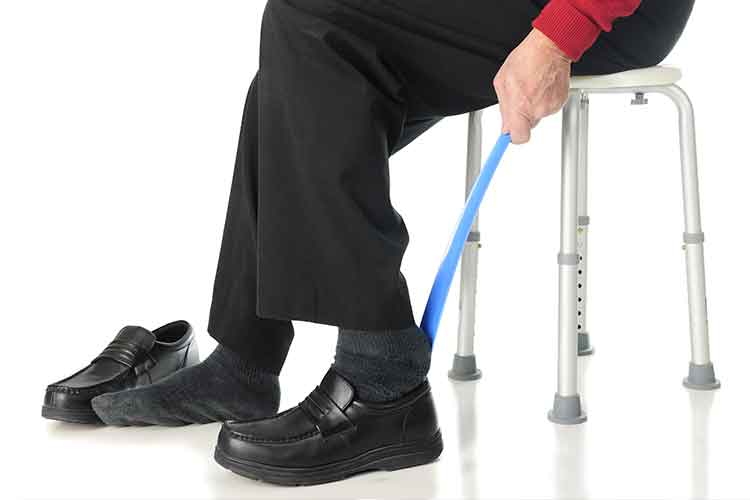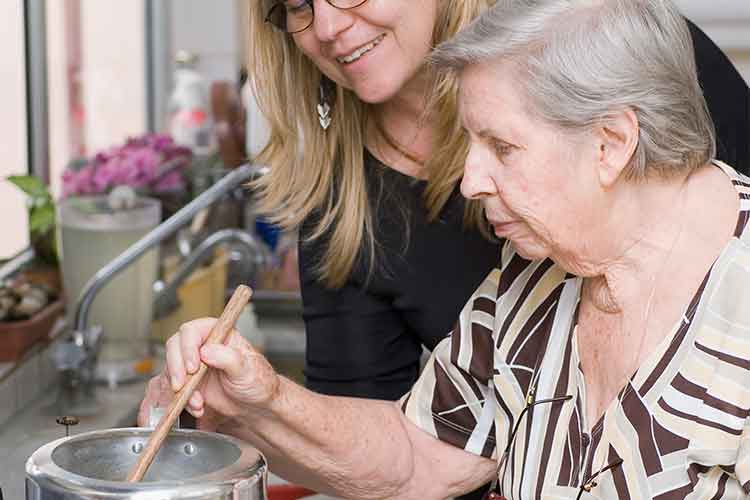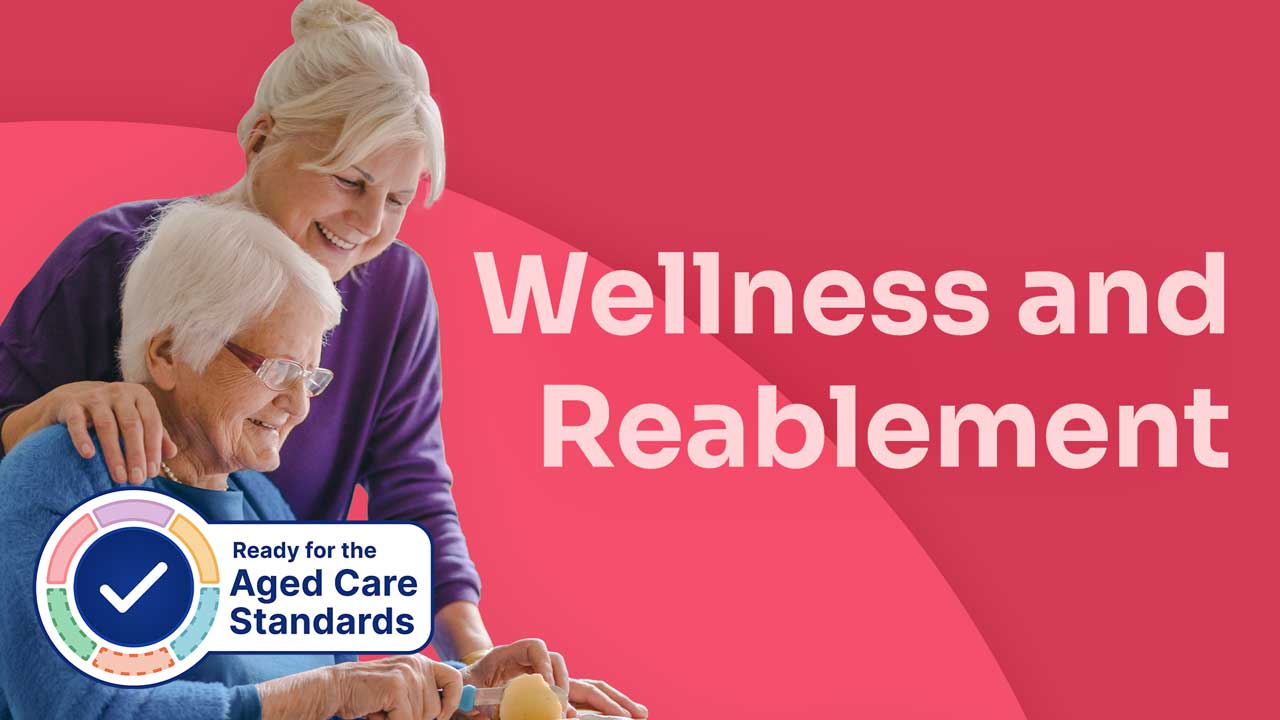Purpose is the difference between existing and living.
Purpose means having clear goals to keep us engaged in our day-to-day lives. Without it, we lack vitality and productivity and risk cognitive and physical decline (Conci 2018).
A wellness and reablement approach to ageing sees older people setting purposeful goals for how they wish to live, to help regain and maintain independence and autonomy, for as long as possible.
What is Wellness and Reablement?
Wellness and reablement is an approach to care grounded in the belief that most people desire and are capable of enhancing their physical, social, and emotional wellbeing to live autonomously and as independently as possible, despite frailty, chronic illness or disability (DoHaAC 2021).
Wellness and reablement rejects the notion that ageing is an irreversible and inevitable decline. Through purposeful engagements, the approach aims to empower older people to improve their quality of life by improving their physical and mental fitness (Fine 2018).
Wellness and reablement can be adopted in both home care and in a residential setting.
Some examples of wellness and reablement activities include:
- A personalised, targeted exercise plan
- Assistive technology or equipment and home modifications (e.g. shower chair, cutlery with large grips, pick-up stick, signs, screen readers)
- Volunteer programs
- Social engagement activities
- Creative engagement (e.g. art classes, music therapy)
- Self-care skills (e.g. cooking for those who may have never learned before).
(Fine 2018; DoHaAC 2021)
Wellness and Reablement Under the Strengthened Aged Care Quality Standards
Standard 3: Care and Services - Outcome 3.1: Assessment and Planning under the strengthened Aged Care Quality Standards(Action 3.1.1) requires aged care providers to establish a planning and assessment system that optimises reablement, quality of life and maintenance of function (ACQSC 2024a).
Furthermore, Outcome 3.2: Delivery of care and services requires providers to deliver care and services in a way that promotes reablement, quality of life and maintenance of function (Action 3.2.2), and ensures older people are promptly referred to appropriate services to support reablement, quality of life and maintenance of function (Action 3.2.4) (ACQSC 2024a).
Standard 5: Clinical Care - Outcome 5.4: Comprehensive care (Action 5.4.2) expects that comprehensive clinical assessments of older people include the planning of clinical care to promote reablement, independence, quality of life and maintenance of function (ACQSC 2024b).
Lastly, Standard 6: Food and Nutrition - Outcome 6.4: Dining experience (Action 6.4.2) aims to ensure that dining experiences in residential aged care facilities support reablement, social, belonging and enjoyment (ACQSC 2024c).
Goal Setting

Once an older person is assessed, in collaboration with their care coordinator, the person identifies their basic needs and larger goals and aspirations. Together, a plan can then be developed to help the client achieve their goals (DoHaAC 2021).
- Older people should first be assessed to understand what is happening in their lives at this time (pre-intervention). Consider adopting a collaborative, ‘strength-based’ approach, which recognises the person as the expert of their own experience and is therefore instrumental to understanding where to go from here.
- Ask broad questions to find out what is most important to the person, what challenges they currently face in life, and what their strengths are.
- Explain to your person what goals are and why you are setting them.
- Individualise your language to what you think will best convey your message.
- Your care plan should be a living document - it will change often, according to the person’s needs, and this should be communicated.
- Consider collaborating with other health professionals or service providers and family members to help align goals.
(Kate Pascale and Associates Pty Ltd 2019)

Benefits of Wellness and Reablement
Along with improving the independence and autonomy of an older person, the benefits of wellness and reablement include:
- Improving function and quality of life in home care settings
- Facilitating integration between residential aged care residents and their local communities
- Embracing a positive and varied professional environment and more autonomy for allied health workers
- Increasing broad social and economic opportunities for the community.
(Conci 2018; Department of Health and Human Services 2018)

Test Your Knowledge
Question 1 of 3
Which one of the following is NOT a benefit of wellness and reablement?
Topics
References
- Aged Care Quality and Safety Commission 2024a, Standard 3: Care and Services, Australian Government, viewed 16 May 2024, https://www.health.gov.au/resources/publications/strengthened-aged-care-quality-standards-august-2025?language=en
- Aged Care Quality and Safety Commission 2024b, Standard 5: Clinical Care, Australian Government, viewed 16 May 2024, https://www.health.gov.au/resources/publications/strengthened-aged-care-quality-standards-august-2025?language=en
- Aged Care Quality and Safety Commission 2024c, Standard 6: Food and Nutrition, Australian Government, viewed 16 May 2024, https://www.health.gov.au/resources/publications/strengthened-aged-care-quality-standards-august-2025?language=en/food-and-nutrition
- Conci, L 2018, Wellness, Reablement and Purposeful Ageing, PowerPoint presentation, viewed 26 April 2024, https://keepable.com.au/wp-content/uploads/2021/05/Day-2-1430-Wellness-and-Reablement-Lidia-Conci-1-March-2018.pdf
- Department of Health and Aged Care 2021, Practical Guide for Embedding Wellness and Reablement Into Service Delivery, Australian Government, viewed 16 May 2024, https://www.health.gov.au/resources/publications/practical-guide-for-embedding-wellness-and-reablement-into-service-delivery?language=en
- Department of Health and Human Services 2018, Wellness and Reablement in the Victorian Home Care Sector, Victorian State Government, viewed 16 May 2024, https://www.vgls.vic.gov.au/client/en_AU/vgls/search/detailnonmodal/ent:$002f$002fSD_ASSET$002f0$002fSD_ASSET:1300342/ada?qu=Home+Care.&d=ent%3A%2F%2FSD_ASSET%2F0%2FSD_ASSET%3A1300342%7EASSET%7E164&ic=true&ps=300&h=8
- Fine, M 2018, ‘Reablement: The Best Aged Care Policy No One Ever Heard of’, Aged Care Insite, 14 December, viewed 26 April 2024, https://www.agedcareinsite.com.au/2018/12/reablement-of-the-best-aged-care-policy-no-one-ever-heard-of/
- Kate Pascale and Associates Pty Ltd 2019, Service Specific Goal Setting and Care Planning for Commonwealth Home Support Programme (CHSP) Service Providers, Kate Pascale and Associates Pty Ltd, viewed 16 May 2024, https://kpassoc.com.au/wp-content/uploads/2019/07/Service-Specific-goal-setting-and-care-planning.pdf

